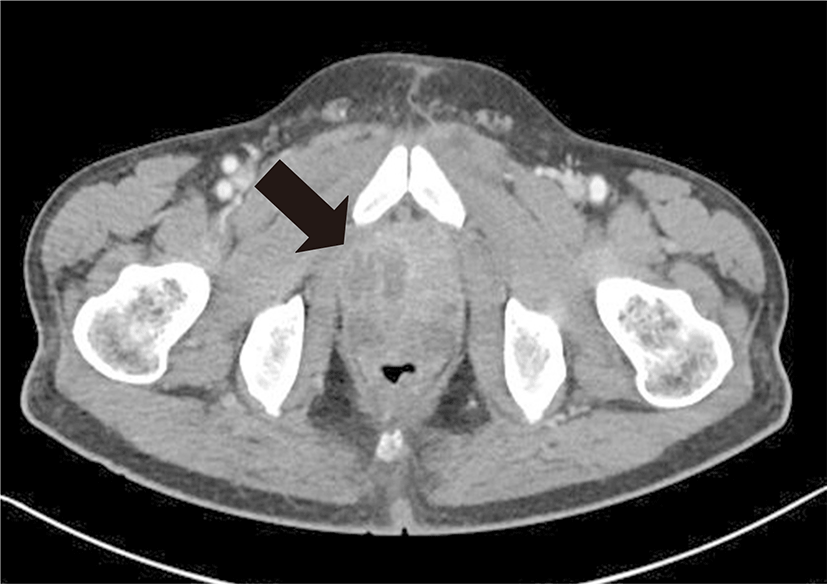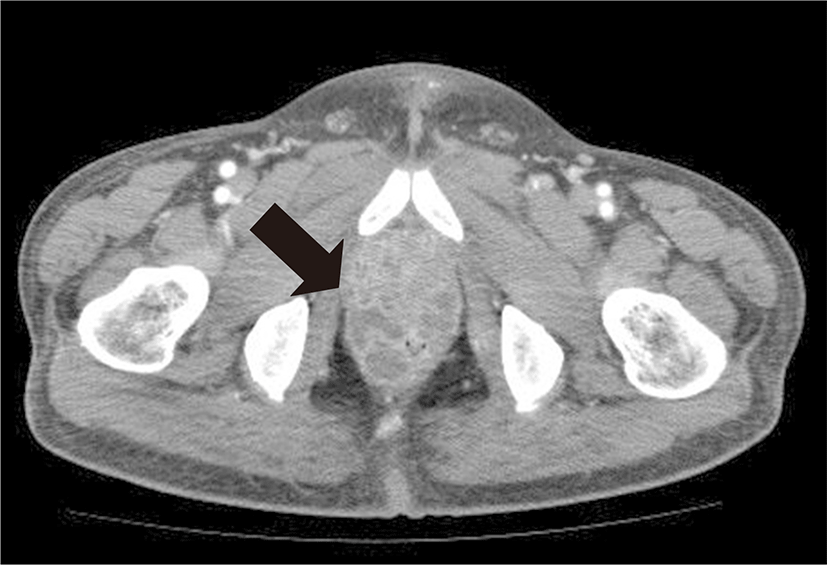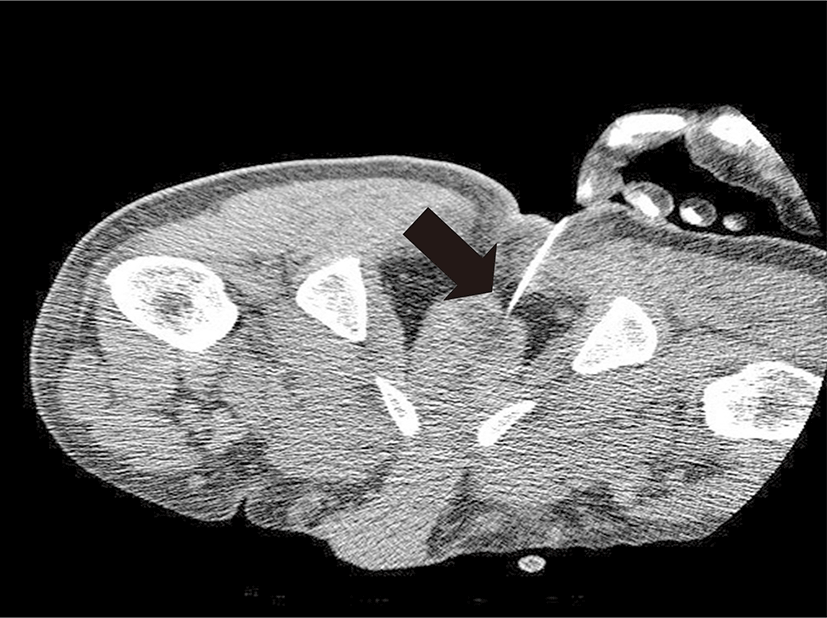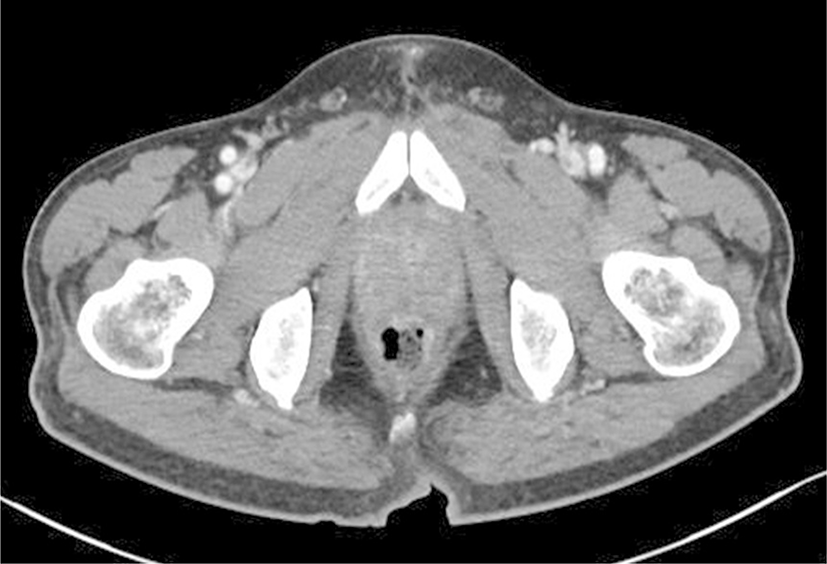Introduction
The prostatic abscess is difficult to diagnose, because at the onset of symptoms it may mimic several other diseases of the lower urinary tract [1]. It is such a rare entity that it is diagnosed in 0.2% of patients presented with urological symptoms [2]. In addition, its mortality is estimated at approximately 6-30% [2]. With the recent development of antibiotics, its prevalence has been decreased. But it is characterized by non-specific symptoms that are suggestive of urinary tract infections. Moreover, it is also characterized by a lack of fluctuation with pain which is one of the typical findings on transrectal palpation of the prostate. This poses an early diagnostic challenge for clinicians [3].
If diagnosed in late stage, it may also lead to the formation of fistula in the urethra, rectus or urinary bladder or cause death due to sepsis despite receiving antibiotic treatments.
For the treatment, clinicians should consider surgical drainage concomitantly with antibiotic treatments. In addition, surgical drainage procedures include transurethral resection of the prostate (TURP) and perineal incision and drainage [4]. But these procedures should be performed under anesthesia. Clinicians should therefore consider the systemic status of patients because such patients are at increased risks of morbidity and mortality. Accordingly, ultrasound-guided transrectal drainage has been a preferred modality because it causes fewer complications [5]. It remains problematic, however, patients with prostate abscess are at increased risks of developing complications such as the formation of fistula in the rectum.
We have performed the treatment on the patient with prostate abscess accompanied by MRSA bacteremia using a percutaneous fine needle aspiration on computed tomography (CT) scans without surgical procedures. Here, we report our case with a review of literatures.
Case
A 48-year-old man complained of a one-week-history of fever, anal pain and left flank pain. The patient also had a 15-year-history of diabetes mellitus, for which the patient had been taking oral anti-hyperglycemic medications. But the patient deliberately stopped taking the medications about 3-4 years ago. Four days before admission, the patient took a third-generation cephalosporin antibiotics but the symptoms worsened. And the patient had no other notable history of medications or urological procedures.
On admission, vital signs include the blood pressure of 120/70 mmHg, heart rate of 100 times/min, respiratory rate of 20 breaths/min and the body temperature of 38.0°C. On physical examination, the patient had acute ill-looking appearance but showed mental alertness. On abdominal examination during admission, the patient had normoactive bowel sound without tenderness or rebound tenderness but had left costovertebral angle tenderness. On complete blood counts, the patient showed WBC counts of 22,600/mm3, erythrocyte sedimentation rate (ESR) of 63 mm/hr, serum C-reactive protein (CRP) levels of 32.7 mg/dL, glycated hemoglobin (HbA1c) 12% and total prostate specific antigen (PSA) 1.354 ng/mL. On urinalysis, the patient showed 10-20 white blood cell/high power field.
On abdominal CT scans, the patient had an enlarged prostate accompanied by multiple abscesses (Fig. 1). In addition, the patient concurrently had findings that are suggestive of acute pyelonephritis in both kidneys.
The patient was intravenously given antibiotics (meropenem 3 g/day) followed by the blood sugar control with insulin. On day 3, the patient was presented with urinary retention, for which the patient underwent suprapubic cystostomy. On blood culture test, the patient had identified MRSA.
Therefore, we switched the antibiotics to 2 g/day of vancomycin with 13.5 g/day of piperacillin/tazobactam. On day 7, the patient underwent abdominal CT; this showed that the patient had an increased size of prostate abscess that invaded into the adjacent bladder and rectum (Fig. 2). We therefore performed a fine-needle aspiration at perianal space under the CT guidance (Fig. 3). After administering local anesthesia with 3-4 mL of lidocaine to the patient in the prone position status, aspiration was conducted using a 20 gauge needle and approximately 7 mL was drained.
On culture of the aspirated abscess, the patient also had identified MRSA as shown on blood culture test. Following the antibiotic treatments and aspiration of the abscess, the patient achieved improvement of the symptoms. On day 22, the patient underwent abdominal CT and had no further findings which were suggestive of the prostate abscess (Fig. 4). Therefore, the patient was discharged from us on day 24.
Discussion
Recently, there has been a decrease in the incidence of prostate abscess with the development of antibiotic therapy. For patients with a persistent presence of fever, dysuria or oliguria due to urinary tract infections despite the antibiotics treatment, clinicians should consider the possibility of prostate abscess [6]. In addition, other clinical symptoms may also include lower abdominal and suprapubic pain, perineal pain and tenesmus [3].
Causative factors for prostate abscess include underlying diseases, such as diabetes mellitus, malignant tumor, chronic renal failure requiring dialysis, immunocompromised status, liver cirrhosis and acquired immunodeficiency syndrome, or urethral catheterization, prostate biopsy, insertion of implants in the lower urinary tract and bladder obstruction [7,8].
As the major causative bacteria for prostate abscess, Neisseria gonorrhoeae have been identified as the most frequent one until thehe period where the antibiotic treatments have become popular [2]. Since the introduction of antibiotic treatments in a clinical setting, infections due to Escherichia coli, belonging to the gram-negative bacterial strains, have become the most popular causative pathogen. In addition, Pseudomonas and anaerobic bacteria have also been reported to be involved in the occurrence of prostate abscess. In recent years, fungal infections have increasingly occurred in patients with immunocompromised status [9].
Therefore, it would be mandatory to make an accurate diagnosis with treatment. Currently, however, there are no established treatment modalities in this series. Clinicians routinely consider antibiotic treatments concomitantly with drainage for the treatment of prostate abscess. But there are no established guidelines for its optimal timing, methods and indications.
Over the past several decades, studies have been conducted to examine the methods for treating the prostate abscess, if ever, only in a limited scope under the retrospective design. In addition, there is a difference in the treatment guideline between the studies. It is therefore difficult to compare the results between the studies. Collado et al. [10] conducted a study on 31 patients who were diagnosed with prostate abscess undergoing ultrasound-guided transrectal drainage, thus reporting that the treatment outcomes were so successful that show 83.3% of total cases achieved improvement of the symptoms. In Korea, Jang et al. [11] conducted a retrospective study on 52 patients. Inconsistent with previous reports, however, these authors showed that the length of hospital stay was greater and the recurrence rate was higher in the ultrasound-guided transrectal drainage group when compared with the transurethral resection prostate group. Ludwig et al. [6] conducted a retrospective study on 18 patients, thus reporting that it would be recommendable to administer intravenous antibiotics and perform suprapubic catheterization in patients with a single abscess of <1 cm in size. A surgical drainage has been recommended to patients with multiple abscess of >1 cm in size, those who are refractory to more than 3-day course of antibiotic regimen, those who concurrently had sepsis or those who had recurrent abscess. But it has not been established as a standard treatment modality.
In the current case, we performed percutaneous drainage under the CT guidance in a patient with multiple abscesses of >1 cm in size, accompanied by MRSA sepsis. We successfully treated our case without recurrence or fistula formation. A percutaneous drainage under the CT guidance is advantageous in that it causes fewer complications such as the formation of fistula between the rectum and prostate gland, bleeding, secondary infections due to the perineal catheterization and discomfort, which is a different feature from ultrasound-guided transrectal drainage. To date, however, only a small number of cases have been reported. Further studies are therefore warranted to establish the optimal timing, methods and indications in patients with prostate abscess.



